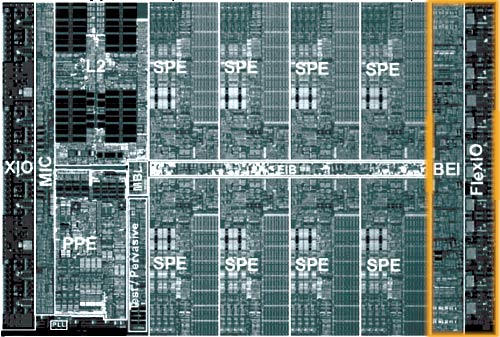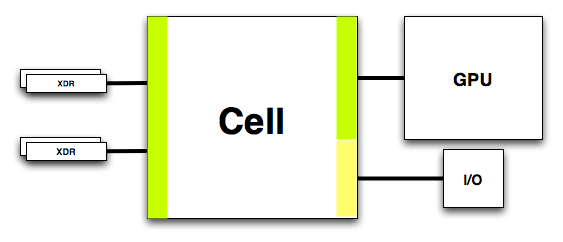Understanding the Cell Microprocessor
by Anand Lal Shimpi on March 17, 2005 12:05 AM EST- Posted in
- CPUs
Cell’s On-Die Memory Controller
For years, we’ve known that Rambus’ memory and interface technology is well ahead of the competition. The problem is that it has never been implemented well on a PC before. The Rambus brand received a fairly negative connotation during the early days of RDRAM on the PC, and things worsened even more for the company’s brand with the Rambus vs. the DDR world lawsuits.Rambus has had success in a lot of consumer electronics devices, such as HDTVs and the Playstation 2, so when Cell was announced to make heavy use of Rambus technologies, it wasn’t too surprising. As we’ve reported before, Rambus technology is used in about 90% of the signaling pins on Cell. The remaining 10% are mostly test pins, so basically, Rambus handles all data going in and out of the Cell processor. They do so in two ways:
First off, Cell includes an on-die dual channel XDR memory controller, each channel being 36-bits wide (32-bits with ECC). Cell’s XDR memory bus runs at 400MHz, but XDR memory transfers data at 8 times the memory bus clock - meaning that you get 3.2GHz data signaling rates. The end result is GPU-like memory bandwidth of 25.6GB/s. As we’ve mentioned in our coverage of this year’s Spring IDF, memory bandwidth requirements increase tremendously as you increase the number of processor cores - with 9 total in Cell, XDR is the perfect fit. Note that the GeForce 6800GT offers 32GB/s of memory bandwidth just to its GPU, so it would not be too surprising to see the Playstation 3’s GPU paired up with its own local memory as well as being able to share system memory and bandwidth.

The block labeled MIC is the XDR memory controller, and the XIO block is the physical layer - all of the input receivers and output drivers are in the XIO block. Data pipelines are also present in the XIO block.
Cell’s On-Die FlexIO Interface
The other important I/O aspect of Cell is also controlled by Rambus - the FlexIO interface. Cell features two configurable FlexIO interfaces, each being 48-bits wide with 6.4GHz data signaling rates.
The BEI block is effectively the North Bridge interface, while the FlexIO block is the physical FlexIO layer.

One potential implementation of Cell’s configurable FlexIO interface.
In Playstation 3, you can pretty much expect a good hunk of this bandwidth to be between NVIDIA’s GPU and the Cell processor, but it also can be used for some pretty heavy I/O interfaces.
One of the major requirements in any high performance game console is bandwidth, and thanks to Rambus, Cell has plenty of it.










70 Comments
View All Comments
ceefka - Thursday, March 17, 2005 - link
Rambus'RevengeLocut0s - Thursday, March 17, 2005 - link
Great article Anand!! Yeah I actually get to bring my Comp150 knowledge to bear in reading this article! If this had come out 6 months ago I would have been totally lost. It will indeed be interesting to see what headway Cell can make, however unfortunately as Anand alludes to the x86 architecture is just too heavily entrenched for anything to budge it except the Big 2 (AMD and Intel). I can't wait to see what type of power the Playstation 3 will have though, and especially how that power will be utilized in games. I bet there will be some jaw dropping graphics awaiting us there. That is if Cells limitations don't hold back lazy game developers and lead to a string of mediocre games punctuated by a few amazing titles made by independent developers who really care to utilize the architecture. Didn't the Playstantion 1 suffer something similar?knitecrow - Thursday, March 17, 2005 - link
The real world technology article on the cell, states that it gives up single thread performance in favour of runing many parallel threads. That sounds like a terrible difficult processor to development games for.I for one think it will be easier to put the burden on the hardware rather than on the software side.
Can we see another repeat of PS2? Technically impressive, but hard to code for.
JarredWalton - Thursday, March 17, 2005 - link
11 - I think the point is that games tend to use certain functions of a CPU much more frequently, while general business/office applications make use of a wider range of generic operations. I understand your complaint, as office applications generally don't need a lot more power than about 1.5 GHz at most. However, the key of the statement was the "general purpose microprocessor" and not the "very powerful" part.AnandThenMan - Thursday, March 17, 2005 - link
WAIT. What the flock does this mean?"Performance in business/office applications requires a very powerful, very fast general purpose microprocessor, but performance in a game console, for example, does not."
WHAT??????? Hello?? So an office app like Word needs a very powerful processor, but a game console does not? I beg to differ. I suppose it depends on how you define "business/office application" but I think that statement is WAY off. I know several current office applications that will limp along on a pentium 133, but no current game has any hope on the same CPU.
tipoo - Wednesday, July 30, 2014 - link
It was clear to me that meant console CPUs didn't have to be as general purpose and brute force powerful in every regard - they can get away with being more specialized, and suck at general work, but still fast for game specific code.Googer - Thursday, March 17, 2005 - link
When are they coming out? Anyone know of a release date?jeffbui - Thursday, March 17, 2005 - link
#4, I do. Heh.I've been waiting for this article forever.. thanks!
JarredWalton - Thursday, March 17, 2005 - link
Interesting stuff. The Playstation has always been something of a pain in the rear to program. PS1 went it's own way, and PS2 did the same. PS3 and Cell seem ready to pave new roads into the "OMG this is really complex" land of programming. I'm glad I've given up serious programming.... :)Googer - Thursday, March 17, 2005 - link
In soviet russia cell processor controls your mind.